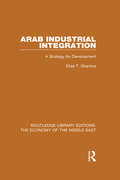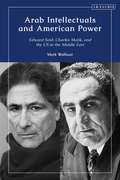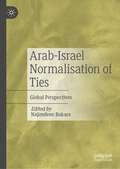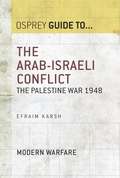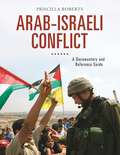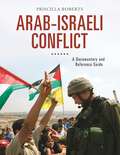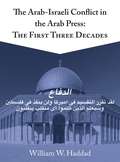- Table View
- List View
The Arab Imago: A Social History of Portrait Photography, 1860–1910
by Stephen SheehiThe first history of indigenous photography in the Middle EastThe birth of photography coincided with the expansion of European imperialism in the Middle East, and some of the medium's earliest images are Orientalist pictures taken by Europeans in such places as Cairo and Jerusalem—photographs that have long shaped and distorted the Western visual imagination of the region. But the Middle East had many of its own photographers, collectors, and patrons. In this book, Stephen Sheehi presents a groundbreaking new account of early photography in the Arab world.The Arab Imago concentrates primarily on studio portraits by Arab and Armenian photographers in the late Ottoman Empire. Examining previously known studios such as Abdullah Frères, Pascal Sébah, Garabed Krikorian, and Khalil Raad, the book also provides the first account of other pioneers such as Georges and Louis Saboungi, the Kova Brothers, Muhammad Sadiq Bey, and Ibrahim Rif'at Pasha—as well as the first detailed look at early photographs of the annual pilgrimage to Mecca. In addition, the book explores indigenous photography manuals and albums, newspapers, scientific journals, and fiction.Featuring extensive previously unpublished images, The Arab Imago shows how native photography played an essential role in the creation of modern Arab societies in Egypt, Palestine, Syria, and Lebanon before the First World War. At the same time, the book overturns Eurocentric and Orientalist understandings of indigenous photography and challenges previous histories of the medium.
Arab Industrial Integration: A Strategy for Development (Routledge Library Editions: The Economy Of The Middle East Ser.)
by Elias T. GhantusThe Arab countries are increasingly recognising their importance as a regional economic grouping. Given the highly skewed distribution of natural, human and financial resources, the course of economic development in the Arab countries seems to be interrelated. Through pooling their resources and markets these countries will not only be able to optimise investment decisions but also broaden the potential for development. This book argues that economic integration is not merely a question of reducing or eliminating discriminatory measures, as emphasised in previous integration attempts. It calls rather for a positive action based on a regional investment strategy which coordinates production programmes, to reap the benefits of specialisation and scale. The book focuses on past industrialisation efforts in the Arab countries and examines the emerging patterns of industrial growth. A pioneering attempt is made to identify specific industries whose economic viability can be enhanced by conceiving them on a regional basis. The book concludes by framing a strategy for an integrated industrial development in the Arab region.First published in 1982.
Arab Industrial Integration (RLE Economy of Middle East): A Strategy for Development
by Elias T. GhantusThe Arab countries are increasingly recognising their importance as a regional economic grouping. Given the highly skewed distribution of natural, human and financial resources, the course of economic development in the Arab countries seems to be interrelated. Through pooling their resources and markets these countries will not only be able to optimise investment decisions but also broaden the potential for development. This book argues that economic integration is not merely a question of reducing or eliminating discriminatory measures, as emphasised in previous integration attempts. It calls rather for a positive action based on a regional investment strategy which coordinates production programmes, to reap the benefits of specialisation and scale. The book focuses on past industrialisation efforts in the Arab countries and examines the emerging patterns of industrial growth. A pioneering attempt is made to identify specific industries whose economic viability can be enhanced by conceiving them on a regional basis. The book concludes by framing a strategy for an integrated industrial development in the Arab region.First published in 1982.
Arab Intellectuals and American Power: Edward Said, Charles Malik, and the US in the Middle East
by M.D. WalhoutEdward Said, the famous Palestinian American scholar and activist, was one of the twentieth century's most iconic public intellectuals, whose pioneering and – to some – controversial work on Orientalism shaped Middle Eastern and postcolonial studies and beyond. But how exactly did he arrive at his famous maxim to 'speak truth to power'?This dual biographical study examines the lives of Edward Said and the eminent Lebanese philosopher and diplomat Charles Malik, a distant relative 30 years his senior whom Said knew from childhood as “Uncle Charles.” To Said, Malik was no ordinary relative; in his memoir, he called Malik “the great negative intellectual lesson of my life”, and was to describe him as “an ideal as I was growing up” only to later claim Malik “went through an ugly transformation that I could never come to terms with”. M.D. Walhout charts the development of these two remarkable figures, reconstructing in the process the way in which American power in the Middle East came to have a defining effect on Arab intellectuals in the twentieth century. Exploring issues of religion and nationalism, Walhout shows how Said came to reject much of what Malik stood for: Christian faith, hardline anti-Communism and the benign nature of American power. He argues that the example of Malik was instrumental in the development of Said's later belief that the true vocation of the intellectual was not to compromise with power, but to resist it.
Arab Intellectuals and American Power: Edward Said, Charles Malik, and the US in the Middle East
by M.D. WalhoutEdward Said, the famous Palestinian American scholar and activist, was one of the twentieth century's most iconic public intellectuals, whose pioneering and – to some – controversial work on Orientalism shaped Middle Eastern and postcolonial studies and beyond. But how exactly did he arrive at his famous maxim to 'speak truth to power'?This dual biographical study examines the lives of Edward Said and the eminent Lebanese philosopher and diplomat Charles Malik, a distant relative 30 years his senior whom Said knew from childhood as “Uncle Charles.” To Said, Malik was no ordinary relative; in his memoir, he called Malik “the great negative intellectual lesson of my life”, and was to describe him as “an ideal as I was growing up” only to later claim Malik “went through an ugly transformation that I could never come to terms with”. M.D. Walhout charts the development of these two remarkable figures, reconstructing in the process the way in which American power in the Middle East came to have a defining effect on Arab intellectuals in the twentieth century. Exploring issues of religion and nationalism, Walhout shows how Said came to reject much of what Malik stood for: Christian faith, hardline anti-Communism and the benign nature of American power. He argues that the example of Malik was instrumental in the development of Said's later belief that the true vocation of the intellectual was not to compromise with power, but to resist it.
Arab-Iranian Relations
by Khair El-Din HaseebRelations between the Arab world and Iran have rarely left the headlines in the last few years, and remain a vital component of international relations in the Middle East. From early disputes over border issues to the Iran-Iraq war of 1980-88, and from later antagonisms between Iran and Saudi Arabia to the current negotiations concerning nuclear weaponry, Syria and other factors, Arab-Iranian relations often hold the key to understanding the conflicts that occur throughout the region. But far from concluding that Arabs and Iranians are inevitably trapped in an antagonistic, and often violent, confrontation, this book instead looks also to examples of and prospects for co-operation and development. Through analysis of a variety of aspects which influence Arab-Iranian relations, such as economic ties, public perception of the relationship, gender dimensions and education, this book offers a comprehensive examination of a vital component of international relations and diplomacy in the Middle East.
Arab-Iranian Rivalry in the Persian Gulf: Territorial Disputes and the Balance of Power in the Middle East (Library Of International Relations Ser.)
by Farzad Cyrus Sharifi-YazdiIranian ambitions in the Persian Gulf and rivalries with Arab neighbours are subject to intense - and heated - speculation, controversy and debate. Here, Farzad Cyrus Sharifi scrutinises the rival Arab-Iranian claims to Bahrain, the Shatt al-Arab waterway, and the Abu Musa and Tunbs islands in the years after World War II and before the Iranian revolution. Through investigation of previously unexamined primary materials and interviews with leading players, this book sheds new light on the evolution and dynamics of hegemonic and nationalistic Arab-Iranian rivalries and how these rivalries began to find symbolic expression through territorial disputes. Sharifi illustrates that these ongoing disputes - and the deep-seated tensions still prevalent in Arab-Iranian relations - are largely rooted in how they were constructed in the post-World War II period, making this book vital reading for researchers of the politics, history, international relations and diplomacy of the Middle East.
Arab-Israel Normalisation of Ties: Global Perspectives
by Najimdeen BakareThis book focuses on rapprochement and normalisation between Israel and some Arab countries within the context of global and regional geopolitics, bringing together broader perspectives on transformations resulting from this. The analysis is rooted in a historical and cultural construction of the region as an Islamic sphere viewing Israel as a perpetuation of the Western colonial project in the region. It analyses how this normalisation must not be treated as a novel phenomenon, but as a reconstruction of the past and continuity in tradition geared at regional stability, signifying a wider shift in the structure of the global international system. The first section addresses the international perspectives of the changing dynamics through the lens of US domestic politics, disengagement plans, China’s increasing understanding of the geopolitics of the Abrahamic world. It equally pays enough attention to the attendant implications of this normalisation. The second section of the book explores the reflections of regional (state and non-state) actors, such as Turkey, Iran, Syria, Pakistan, and Hezbollah, and the catalysing effects of this normalisation within and beyond the region. The book is a rich resource for scholars of regional and international relations, in particular Middle East studies. It provides useful reading material for both undergraduate and graduate students of Political Science, think tanks, diplomats, and IR experts and policy analysts, who are desirous of having rich theoretical and empirical underpinnings of unfolding realities in the larger Middle East.
The Arab-Israeli Conflict (Studies in Contemporary Europe)
by T.G. FraserAn analysis of the principal stages and issues of the Arab-Israeli Conflict since 1945. The Introduction sets out the origins of Arab Nationalism and Zionism, and traces their varying fortunes through the agreements of the First World War, the British Mandate and the Holocaust. The book goes on to examine the creation of Israel and the collapse of Arab Palestine. It explains the consolidation of the conflict through the events of 1956 and analyses the crisis period of the 1967 and 1973 war. The final chapter traces the various attempts to reach a settlement, with particular emphasis on recent events.
The Arab-Israeli Conflict
by Thomas FraserT. G. Fraser provides a balanced and thoughtful analysis of one of the most tragic conflicts in modern history. From the creation of Israel to the situation today, this text follows the key events and issues arising from the partition of Palestine. The major regional wars and Palestinian Intifadas are examined, with a particular focus on the series of crises over Gaza.This thoroughly updated edition features a new final chapter, covering events since 2007. It takes into account attempts by the USA to work towards a peace settlement, including John Kerry's initiative of 2013-14. These much-needed additions ensure that The Arab-Israeli Conflict remains an invaluable guide for students of the Middle East.
The Arab-Israeli Conflict: The Palestine War 1948 (Guide to...)
by Professor Efraim KarshThe Palestine War has been by far the most important military encounter in the history of the Arab-Israeli conflict. This book examines the origins of the war and its progression through two distinct stages: the guerrilla warfare between the Arab and Jewish communities of Mandatory Palestine, and the conventional inter-state war between the State of Israel and the invading Arab armies. In doing so it assesses the participants, their war aims, strategies and combat performance. Finally, it examines the reasons for Israel's success in the face of seemingly impossible odds and for the failure of the Arab nations to turn their military and numerical superiority into victory on the ground.
The Arab-Israeli Conflict: A Ringside View
by P.R. KumaraswamyThis book provides a holistic view of the conflict between Israel and its Arab neighbours and studies the global implications of their fraught relations. Focusing on the conflict from its beginning in the late 19th century, the author provides a well-rounded and balanced narrative by examining its religious, ideological, ethnic, political, national, regional and international dimensions. The volume covers a wide range of issues, such as the conflicting historical legacy of the city of Jerusalem, Jewish longing for a homeland, the partition of Palestine, various wars and conflicts since 1948, Palestinian resistance, the Arab Boycott of Israel and the Abraham Accords. It also tackles the contested national claims and the refugee question and looks at various peace-making efforts, including the role of external stakeholders such as the US, UK, Russia and India. A comprehensive study of the Arab-Israeli conflict, the book is richly supported by a swath of references to materials, documents, maps and video links. It will be an essential reading for students, academics and teachers of politics and international relations, national security, geopolitics, history, military and strategic studies, Middle East studies, conflict resolution and peace-making.
The Arab-Israeli Conflict: A Ringside View
by P.R. KumaraswamyThis book provides a holistic view of the conflict between Israel and its Arab neighbours and studies the global implications of their fraught relations. Focusing on the conflict from its beginning in the late 19th century, the author provides a well-rounded and balanced narrative by examining its religious, ideological, ethnic, political, national, regional and international dimensions. The volume covers a wide range of issues, such as the conflicting historical legacy of the city of Jerusalem, Jewish longing for a homeland, the partition of Palestine, various wars and conflicts since 1948, Palestinian resistance, the Arab Boycott of Israel and the Abraham Accords. It also tackles the contested national claims and the refugee question and looks at various peace-making efforts, including the role of external stakeholders such as the US, UK, Russia and India. A comprehensive study of the Arab-Israeli conflict, the book is richly supported by a swath of references to materials, documents, maps and video links. It will be an essential reading for students, academics and teachers of politics and international relations, national security, geopolitics, history, military and strategic studies, Middle East studies, conflict resolution and peace-making.
The Arab-Israeli Conflict: An Introduction and Documentary Reader
by Gregory S. Mahler Alden R.W. MahlerThe Arab-Israeli conflict has been one of the most protracted and contentious disputes in the Middle East. This wide-ranging textbook examines the diplomatic and historical setting within which the conflict developed, from both the Israeli and Palestinian perspectives, and gives a comprehensive overview of the peace process. Enabling students to easily access and study original documents through the supportive framework of a textbook, The Arab-Israeli Conflict: presents the seventy most important and widely cited documents in the history of the Israeli-Palestinian conflict presents these documents in an edited form to highlight key elements includes an introductory chapter which sets the context for the study of the history of the area covers a comprehensive historical period, ranging from the 19th Century to the present day incorporates a wide range of pedagogical aids: original documents, maps and boxed sections. This important textbook is an essential aid for courses on the Arab-Israeli conflict and the Middle East peace process, and will be an invaluable reference tool for all students of political science, Middle East studies and history.
The Arab-Israeli Conflict: An Introduction and Documentary Reader
by Gregory S. Mahler Alden R.W. MahlerThe Arab-Israeli conflict has been one of the most protracted and contentious disputes in the Middle East. This wide-ranging textbook examines the diplomatic and historical setting within which the conflict developed, from both the Israeli and Palestinian perspectives, and gives a comprehensive overview of the peace process. Enabling students to easily access and study original documents through the supportive framework of a textbook, The Arab-Israeli Conflict: presents the seventy most important and widely cited documents in the history of the Israeli-Palestinian conflict presents these documents in an edited form to highlight key elements includes an introductory chapter which sets the context for the study of the history of the area covers a comprehensive historical period, ranging from the 19th Century to the present day incorporates a wide range of pedagogical aids: original documents, maps and boxed sections. This important textbook is an essential aid for courses on the Arab-Israeli conflict and the Middle East peace process, and will be an invaluable reference tool for all students of political science, Middle East studies and history.
Arab-Israeli Conflict: A Documentary and Reference Guide (Documentary and Reference Guides)
by Priscilla RobertsCovering the Arab-Israeli conflict from its origins to the present, this valuable resource traces the evolution of this ongoing, seemingly unresolvable dispute through a wide array of primary source documents.Arab-Israeli Conflict: A Documentary and Reference Guide provides a fresh, accessible, and thorough overview of the Arab-Israeli conflict, covering its origins in the late-19th century to the present-day situation and enabling readers to grasp why peace has proved so elusive, despite massive international efforts to reach a permanent and lasting solution to this protracted animosity.Chronological chapters first address the years up to the establishment of Israel in 1948, then move forward to the wars of 1956 and 1967 and their impact; the 1973 Yom Kippur War and early efforts to reach a lasting peace settlement; and the ongoing international and Israeli-Palestinian negotiations since the mid-1980s. Readers will come away with not only an understanding of why so many great powers were from the beginning interested in the fate of the territory known as Palestine and of the current issues from an international perspective, but also an appreciation of the personalities and ethnic backgrounds involved that make the conflict so difficult to resolve.
Arab-Israeli Conflict: A Documentary and Reference Guide (Documentary and Reference Guides)
by Priscilla RobertsCovering the Arab-Israeli conflict from its origins to the present, this valuable resource traces the evolution of this ongoing, seemingly unresolvable dispute through a wide array of primary source documents.Arab-Israeli Conflict: A Documentary and Reference Guide provides a fresh, accessible, and thorough overview of the Arab-Israeli conflict, covering its origins in the late-19th century to the present-day situation and enabling readers to grasp why peace has proved so elusive, despite massive international efforts to reach a permanent and lasting solution to this protracted animosity.Chronological chapters first address the years up to the establishment of Israel in 1948, then move forward to the wars of 1956 and 1967 and their impact; the 1973 Yom Kippur War and early efforts to reach a lasting peace settlement; and the ongoing international and Israeli-Palestinian negotiations since the mid-1980s. Readers will come away with not only an understanding of why so many great powers were from the beginning interested in the fate of the territory known as Palestine and of the current issues from an international perspective, but also an appreciation of the personalities and ethnic backgrounds involved that make the conflict so difficult to resolve.
Arab-Israeli Conflict: The Essential Reference Guide
by Priscilla RobertsTruly an essential reference for today's world, this detailed introduction to the origins, events, and impact of the adversarial relationship between Arabs and Israelis illuminates the complexities and the consequences of this long-lasting conflict.The Arab-Israeli conflict remains one of the most contentious in modern history, one with repercussions that reach far beyond the Middle East. This volume describes and explains the most important countries, people, events, and organizations that play or have played a part in the conflict. Chronological coverage begins with the Israeli War of Independence in 1948 and extends to the present day. A one-stop reference, the guide offers a comprehensive overview essay, as well as perspective essays by leading scholars who explore such widely debated issues as the United States' support for Israel and historic rights to Palestine.Important primary source documents, such as the UN Resolution on the Partition of Palestine and the Camp David Accords, are included and put into context. Further insight into drivers of war and peace in the Middle East are provided through biographies of major political leaders like Menachem Begin, Golda Meir, Yasser Arafat, Benjamin Netanyahu, and Anwar Sadat.
Arab-Israeli Conflict: The Essential Reference Guide (Documentary And Reference Guides)
by Priscilla RobertsTruly an essential reference for today's world, this detailed introduction to the origins, events, and impact of the adversarial relationship between Arabs and Israelis illuminates the complexities and the consequences of this long-lasting conflict.The Arab-Israeli conflict remains one of the most contentious in modern history, one with repercussions that reach far beyond the Middle East. This volume describes and explains the most important countries, people, events, and organizations that play or have played a part in the conflict. Chronological coverage begins with the Israeli War of Independence in 1948 and extends to the present day. A one-stop reference, the guide offers a comprehensive overview essay, as well as perspective essays by leading scholars who explore such widely debated issues as the United States' support for Israel and historic rights to Palestine.Important primary source documents, such as the UN Resolution on the Partition of Palestine and the Camp David Accords, are included and put into context. Further insight into drivers of war and peace in the Middle East are provided through biographies of major political leaders like Menachem Begin, Golda Meir, Yasser Arafat, Benjamin Netanyahu, and Anwar Sadat.
The Arab-Israeli Conflict (Seminar Studies)
by Kirsten E. SchulzeIn this concise yet comprehensive survey, Kirsten E. Schulze analyzes the causes, course and consequences of the Arab–Israeli conflict, exploring the particular dynamics of this conflict and the numerous attempts at its resolution. Covering pivotal events ranging from the creation of the State of Israel to the first and second Lebanon Wars and the Arab Spring, the book traces the development of the conflict from its intellectual roots in the nineteenth century to the present day. This third edition has been revised throughout to bring the text up to date with recent events, including: • a completely new chapter on the Gaza Wars from 2006 to 2014 • new material on the Arab Spring and its implications for Israel • an updated discussion of the ongoing negotiations for peace. Containing a diverse collection of primary source documents, a chronology of key dates, a glossary, a guide to further reading and a Who’s Who summarizing the careers and contributions of the main figures, this book is essential to understanding the background to and worldwide significance of the continuing violence between Israel and Palestine and is valuable reading for all students of the Arab–Israeli conflict.
The Arab-Israeli Conflict (Seminar Studies)
by Kirsten E. SchulzeIn this concise yet comprehensive survey, Kirsten E. Schulze analyzes the causes, course and consequences of the Arab–Israeli conflict, exploring the particular dynamics of this conflict and the numerous attempts at its resolution. Covering pivotal events ranging from the creation of the State of Israel to the first and second Lebanon Wars and the Arab Spring, the book traces the development of the conflict from its intellectual roots in the nineteenth century to the present day. This third edition has been revised throughout to bring the text up to date with recent events, including: • a completely new chapter on the Gaza Wars from 2006 to 2014 • new material on the Arab Spring and its implications for Israel • an updated discussion of the ongoing negotiations for peace. Containing a diverse collection of primary source documents, a chronology of key dates, a glossary, a guide to further reading and a Who’s Who summarizing the careers and contributions of the main figures, this book is essential to understanding the background to and worldwide significance of the continuing violence between Israel and Palestine and is valuable reading for all students of the Arab–Israeli conflict.
The Arab-israeli Conflict In The Arab Press: The First Three Decades (PDF)
by William W. HaddadThis monograph provides a much-needed history of the Arab print media as well as an in-depth study of translated Arab media sources, remedying a remarkable gap in Western intellectual culture. Setting the scene, the manuscript begins with a brief historical narrative of Arab newspapers from the 1940s to the mid-1970s, when a free press virtually disappeared. William Haddad then explores the historiography of the Arab print media, compiling a valuable collection of available scholarship on the subject. The book simultaneously considers the contemporary ongoing problem of censorship in Middle East journalism. With this valuable context, Haddad then sets about examining the Arab print media's view of the Arab-Israeli conflict in its first three decades. By giving voice to the Arab political journalists who wrote editorials and opinion pieces, the bulk of the book explores the variety of opinions held in the Arab print media regarding the Arab-Israeli conflict.
The Arab-Israeli Conflict in the Media: Producing Shared Memory and National Identity in the Global Television Era
by Tamar AshuriThe television industry has metamorphosised from a national and largely-monopolized sector to a commercial and global enterprise. This has profoundly altered the way 'historical truth' and shared memory are constructed and conveyed. Here Ashuri provides a groundbreaking study of the changes through the vantage point of an illuminating mode of television production, international co-productions. By taking an example based on current events in the Middle East - a television documentary on the Arab Israeli conflict co-produced by three television networks (BBC, PBS, MBC) - her study enriches contemporary media research, providing an unprecedented, behind-the-scenes look at the entire production process of a co-produced television history.She shows that making the documentary on the Arab-Israeli struggle turned into a war: a war over competing memories, interpretation, editing, and finally narration. Ashuri's analysis of transnational documentary collaborations reveals inherent tensions between economic constraints and cultural forces, between the local and global, and between 'shared' and 'cosmopolitan' memory.Enriching political economy studies of media by exploring the cultural negotiations at the heart of television production process, and highlighting the economic processes that underlie the contested constructions of national histories, "The Arab-Israeli Conflict in the Media" will be essential reading for those interested in media and television studies, as well as globalization and cultural identity.
The Arab-israeli Conflict (PDF)
by Tony McaleavyA range of textbooks covering many of the options available on GCSE history specifications. The Arab-Israeli Conflict is full colour throughout, highly illustrated and include a range of activities to motivate students.
The Arab-Israeli Conflict, Volume IV, Part I: The Difficult Search for Peace (1975-1988)
by John Norton MooreVolume IV of The Arab-Israeli Conflict is a fundamental research tool for students of the Middle East and for those responsible for U.S. policy-making in that area. It is a successor to John Norton Moore's widely acclaimed three-volume compilation of readings and documents on international law and the Arab-Israeli conflict and to the one-volume abridged edition of that compilation, published by Princeton University Press in 1974 and 1977 respectively. Additionally, Volume IV stands on its own as a documentary history of the period from the September 1975 Sinai accords through the Shultz peace initiative and the Palestinian uprising in December 1988.Originally published in 1991.The Princeton Legacy Library uses the latest print-on-demand technology to again make available previously out-of-print books from the distinguished backlist of Princeton University Press. These editions preserve the original texts of these important books while presenting them in durable paperback and hardcover editions. The goal of the Princeton Legacy Library is to vastly increase access to the rich scholarly heritage found in the thousands of books published by Princeton University Press since its founding in 1905.

